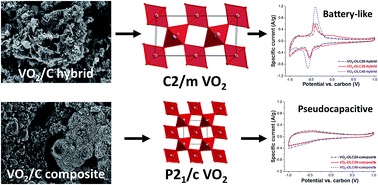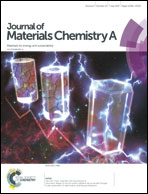Tuning pseudocapacitive and battery-like lithium intercalation in vanadium dioxide/carbon onion hybrids for asymmetric supercapacitor anodes†
Abstract
The study presents the synthesis of vanadium oxide/carbon onion hybrid materials. Flower-like vanadium oxide nanostructures nucleate on carbon onion nanoparticles under hydrothermal conditions, forming a highly intertwined network. By varying the amount of added carbon onions during the synthesis, the number of possible nucleation sites can be adjusted, resulting in the preferential growth of vanadium dioxide in either P21/c or C2/m space group. When employed as a lithium intercalation electrode, P21/c VO2 exhibits capacitor-like (pseudocapacitive) lithium intercalation, whereas C2/m VO2 shows battery-like intercalation peaks with a maximum capacity of 127 mA h g−1. By selecting an optimum ratio and thereby combining both intercalation mechanisms, enhanced kinetics with discharge capacities of 45 mA h g−1 and 29 mA h g−1 at high rates of 50 A g−1 and 100 A g−1 (equal to 394C and 788C) are obtained. This behavior can be translated to a device level by using the material as anodes in asymmetric supercapacitors with activated carbon cathodes, yielding a maximum specific energy of 45 W h kg−1 and a high power of 58 kW kg−1, while longevity over 5000 charge/discharge cycles is demonstrated.



 Please wait while we load your content...
Please wait while we load your content...